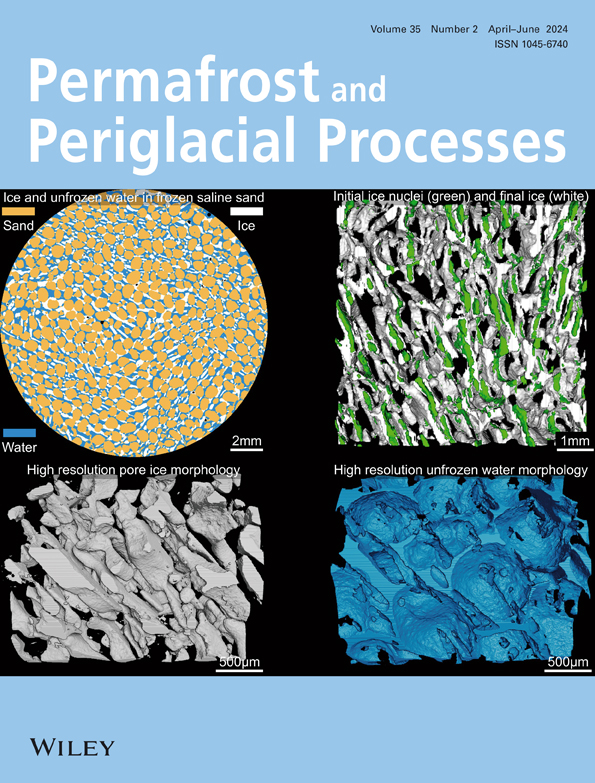Spatial and temporal dynamics of aufeis in the Tso Moriri basin, eastern Ladakh, India
IF 3.3
3区 地球科学
Q2 GEOGRAPHY, PHYSICAL
引用次数: 1
Abstract
Aufeis is a common phenomenon in cold regions of the Northern Hemisphere that develops during winter by successive water overflow and freezing on ice‐covered surfaces. Most studies on aufeis occurrence focus on regions in North America and Siberia, while research in High Mountain Asia (HMA) is still in an exploratory phase. This study investigates the extent and dynamics of icing processes and aufeis in the Tso Moriri basin, eastern Ladakh, India. Based on a combination of 235 Landsat 5 TM/8 OLI and Sentinel‐2 imagery from 2008 to 2021 the occurrence of icing and aufeis was classified using a random forest classifier. A total of 27 frequently occurring aufeis fields with an average maximum extent of 9 km2 were identified, located at a mean elevation of 4,700 m a.s.l. Temporal patterns show a distinct accumulation phase (icing) between November and April, and a melting phase lasting from May until July. Icing is characterized by high seasonal and inter‐annual variability. Successive water overflow mainly occurs between January and March and seems to be related to diurnal freeze–thaw‐cycles, whereas higher daytime temperatures result in larger icing areas. Aufeis feeding sources are often located within or in close vicinity to wetland areas, while vegetation is largely absent on surfaces with frequent aufeis formation. These interactions require more attention in future research. In addition, this study shows the high potential of a machine learning approach to monitor icing processes and aufeis, which can be transferred to other regions.印度拉达克东部措莫里里盆地森林植被时空动态
Aufeis是北半球寒冷地区的一种常见现象,在冬季,由于水连续溢出和冰层表面结冰而形成。大多数关于aufeis发生的研究集中在北美和西伯利亚地区,而亚洲高山地区的研究仍处于探索阶段。本研究调查了印度拉达克东部措莫里里盆地结冰过程和aufei的范围和动力学。基于2008年至2021年235幅Landsat 5 TM/8 OLI和Sentinel‐2图像的组合,使用随机森林分类器对结冰和aufeis的发生进行了分类。共确定了27个频繁出现的aufeis油田,平均最大面积为9km2,位于平均海拔4700 m a.s.l.时间模式显示,11月至4月之间有一个明显的积累阶段(结冰),5月至7月为融化阶段。结冰的特点是季节性和年际变化较大。连续的水溢流主要发生在1月至3月之间,似乎与白天的冻融循环有关,而白天温度越高,结冰面积越大。Aufeis的食物来源通常位于湿地内或附近,而Aufeis频繁形成的表面基本上没有植被。这些相互作用需要在未来的研究中给予更多关注。此外,这项研究表明,机器学习方法在监测结冰过程和aufeis方面具有很高的潜力,可以转移到其他地区。
本文章由计算机程序翻译,如有差异,请以英文原文为准。
求助全文
约1分钟内获得全文
求助全文
来源期刊
CiteScore
9.70
自引率
8.00%
发文量
43
审稿时长
>12 weeks
期刊介绍:
Permafrost and Periglacial Processes is an international journal dedicated to the rapid publication of scientific and technical papers concerned with earth surface cryogenic processes, landforms and sediments present in a variety of (Sub) Arctic, Antarctic and High Mountain environments. It provides an efficient vehicle of communication amongst those with an interest in the cold, non-glacial geosciences. The focus is on (1) original research based on geomorphological, hydrological, sedimentological, geotechnical and engineering aspects of these areas and (2) original research carried out upon relict features where the objective has been to reconstruct the nature of the processes and/or palaeoenvironments which gave rise to these features, as opposed to purely stratigraphical considerations. The journal also publishes short communications, reviews, discussions and book reviews. The high scientific standard, interdisciplinary character and worldwide representation of PPP are maintained by regional editorial support and a rigorous refereeing system.

 求助内容:
求助内容: 应助结果提醒方式:
应助结果提醒方式:


